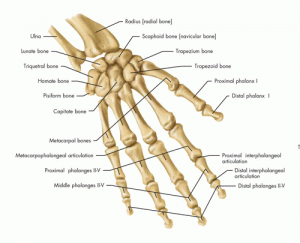MUCOUS CYST
A small fluid-filled sac originating from the joint closest to the fingernail on the thumb or fingers, mucous cysts affect for than 200,000 individuals per year. A form of ganglion cysts origination from the capsule of the joint at the end of the finger, the mucous cyst grows out of the joint attached to a “stalk”. The stalk allows fluid to move into the cyst from the joint. The mucous cyst can occasionally drain thin or thick fluid and can cause the nail to form a small ridge in it. The cyst can cause pain and even get infected if left untreated for a prolonged amount of time. The cyst typically forms from a joint that has osteoarthritis. Due to wear and tear over time, osteoarthritis develops from a loss of normal, smooth, healthy cartilage. Bone spurs, or osteophytes form in response to bone rubbing against bone when a joint lacks cartilage. In hands with arthritis and mucous cysts present, bone spurs form on both sides of the joint. The bone spurs then rub against each other and irritate the synovial lining of the joint. The irritated synovium of an arthritic joint forms a sac that fills with synovial fluid. Doctors call this fluid filled sac a mucous cyst when located in the finger. When the cyst lies within the hand or wrist, physicians call the cyst a ganglion cyst.
HOW do doctors diagnose mucous cysts?
Most mucous cysts do not cause pain or harm to patients. For these instances, individuals with mucous cysts should keep an eye on the cyst since they often self-resolve over time. Non-painful mucous cysts do not need treatment from a physician. If pain, recurrent drainage, or a nail deformity develop, a physician has multiple options to treat the mucous cyst.
To treat a mucous cyst, hand and wrist orthopedic specialists start with administering a physical examination. During the physical examination, the provider asks the patient about any medical and family history. The provider then performs physical tests on the hand. To diagnose a mucous cyst, the physician typically only needs to look at the hand to determine the type of cyst. The physician may order additional diagnostic testing to ensure no underlying issues or conditions exist within the hand.
HOW do doctors treat mucous cysts?
When determining treatment for a mucous cyst, hand and wrist physicians often attempt conservative treatment first. Conservative treatment of mucous cysts usually consists of aspirations. Physicians may initially aspirate a mucous cyst with a syringe despite a high rate of reoccurrence due to the ease and low cost of the potential fix. Insurance companies may require doctors to attempt conservative treatments before opting for surgical treatment. To permanently cure the mucous cyst, physicians often resort to surgical intervention. For surgical treatment of mucous cysts, an anesthesiologist places the patient under regional anesthesia. Under regional anesthesia, the doctor numbs a cluster or nerves which in turn numbs a single area of the body. In the case of mucous cyst excision surgery, the doctor numbs the patients lower arm or hand. This allows the surgeon to perform the procedure without putting the patient asleep. This makes mucous cyst excision a very safe procedure. Doctors prefer surgical intervention to treat mucous cyst due to approaching the root source of the cyst. In surgical treatment of mucous cysts, doctors can remove the bone spur, stalk, and the cyst. Doctors must remove to entire stalk to ensure the cyst does not reoccur. Physicians may additionally remove some of the skin on the finger if the cyst has grown too close to separate. In cases where the physician needs to remove some of the skin, the physician replaces the removed skin with a small skin graft. Preforming this half an hour outpatient procedure under regional anesthesia, the physician resolves the mucous cyst and sends the patient home with post-operative instructions.
Recovering from mucous cyst removal
The physician take the stitches out within one to two weeks following the procedure. The physician prescribes the patient moderate physical therapy to ensure the patient has optimal recovery. Most patients return back to regular activities within three weeks following surgical treatment of a mucous cyst.
activities within three weeks following surgical treatment of a mucous cyst.
To view a list of all insurances that AOA Orthopedic Specialists accept, click HERE. To schedule an appointment online, click HERE.

